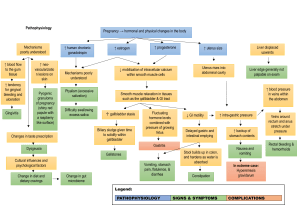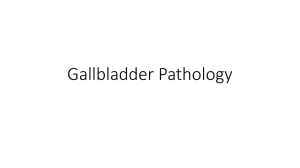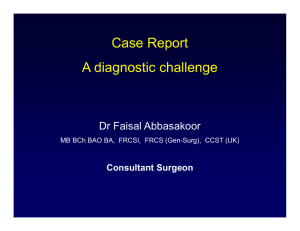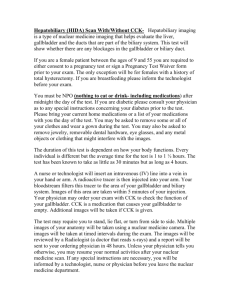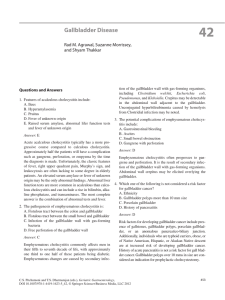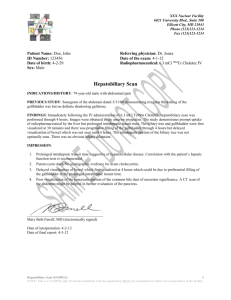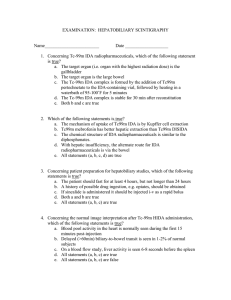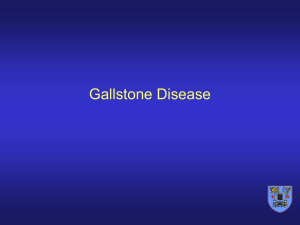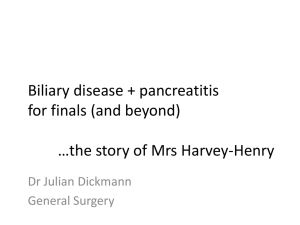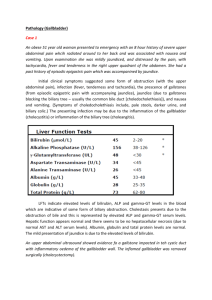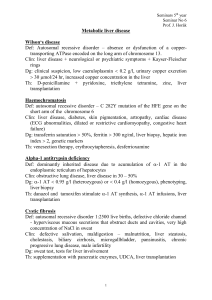Gallbladder Disease
advertisement
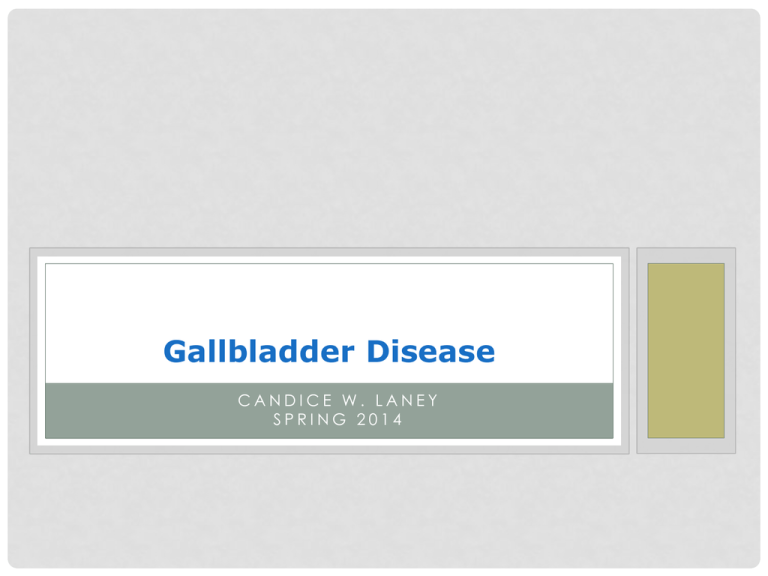
Gallbladder Disease CANDICE W. LANEY SPRING 2014 Question Is the following statement True or False? Bile is stored in the gallbladder. Answer True Bile is stored in the gallbladder. A&P Review: Liver, Biliary System, and Pancreas Cholelithiasis • Pathophysiology – Pigment stones – Cholesterol stones • Risk factors ― Obesity ― Drugs ― Rapid Weight Loss ― Dehydration ― Increased triglycerides ― Fatty Diet Cholelithiasis—Manifestations • May have no or minimal symptoms and may be acute or chronic. • Epigastric distress: fullness, abdominal distention, vague upper right quadrant pain. Distress may occur after eating a fatty meal. • Acute symptoms occur with obstruction and inflammation or infection: fever, palpable abdominal mass, severe right abdominal that radiates to the back or right shoulder, nausea and vomiting. • Biliary colic is episodes of severe pain usually associated with nausea and vomiting, which usually occur several hours after a heavy meal. • Jaundice may develop due to blockage of the common bile duct. CHOLECYSTITIS Cholecystitis is inflammation of the gallbladder. Acute cholecystitis is caused primarily by gallstone obstruction of the cystic duct with edema, inflammation, and bacterial invasion. It may also occur in the absence of stones, as a result of major surgical procedures, severe trauma, or burns. Chronic cholecystitis results from repeated attacks of cholecystitis, presence of stones, or chronic irritation. The gallbladder becomes thickened, rigid, fibrotic, and functions poorly. CHOLECYTITIS- MANIFESTATIONS Symptoms The main symptom is pain in the upper right side or upper middle of the abdomen. The pain may: •Be sharp, cramping, or dull •Be steady •Spread to the back or below the right shoulder blade Other symptoms that may occur include: •Clay-colored stools •Fever •Nausea and vomiting •Yellowing of skin and whites of the eyes (jaundice) DIAGNOSITICS Exams and Tests A physical exam will show that your abdomen is tender to the touch. Your doctor may order the following blood tests: •Amylase and lipase •Bilirubin •Complete blood count -- may show a higher than normal white blood cell count •Liver function tests Imaging tests that can show gallstones or inflammation include: Abdominal CT/US/ X-Ray •Oral cholecystogram •Gallbladder radionuclide scan Question Is the following statement True or False? Cholecystitis is when a patient has calculi in the gallbladder. Answer False Cholelithiasis is when a patient has calculi in the gallbladder. Cholecystitis is inflammation of the gallbladder. Medical Management of Cholelithiasis • Cholecystectomy • Laparoscopic cholecystectomy • Dietary management • Medications: ursodeoxycholic acid and chenodeoxycholic acid • Nonsurgical removal – By instrumentation – Intracorporeal or extracorporeal lithotripsy Nonsurgical Techniques for Removing Gallstones Laparoscopic Cholecystectomy Cholesterol Gallstones and Pigment Gallstones Nursing Process: The Care of the Patient Undergoing Surgery for Gallbladder Disease—Assessment • Patient history • Knowledge and teaching needs • Respiratory status and risk factors for respiratory complications postoperative • Nutritional status • Monitor for potential bleeding • Gastrointestinal symptoms: after laparoscopic surgery asses for loss of appetite, vomiting, pain, distention, fever—potential infection or disruption of GI tract Nursing Process: The Care of the Patient Undergoing Surgery for Gallbladder Disease—Diagnoses • Acute pain • Impaired gas exchange • Impaired skin integrity • Imbalanced nutrition • Deficient knowledge Collaborative Problems/Potential Complications • Bleeding • Gastrointestinal symptoms • Complications as related to surgery in general: atelectasis, thrombophlebitis Nursing Process: The Care of the Patient Undergoing Surgery for Gallbladder Disease—Planning • Goals may include relief of pain, adequate ventilation, intact skin, improved biliary drainage, optimal nutritional intake, absence of complications, and understanding of self-care routines. Postoperative Care Interventions • Low Fowler’s position • May have NG • NPO until bowel sounds return, then a soft, low-fat, high-carbohydrate diet postoperatively • Care of biliary drainage system • Administer analgesics as ordered and medicate to promote/permit ambulation and activities, including deep breathing • Turn, and encourage coughing and deep breathing, splinting to reduce pain • Ambulation Patient Teaching—See Chart 40-3 • Medications • Diet: at discharge, maintain a nutritious diet and avoid excess fat. Fat restriction is usually lifted in 4–6 weeks. • Instruct in wound care, dressing changes, care of Ttube • Activity • Instruct patient and family to report signs of gastrointestinal complications, changes in color of stool or urine, fever, unrelieved or increased pain, nausea, vomiting, and redness/edema/signs of infection at incision site
